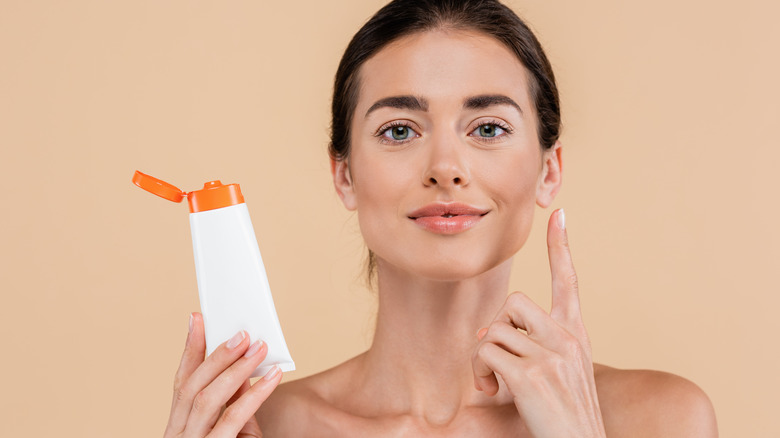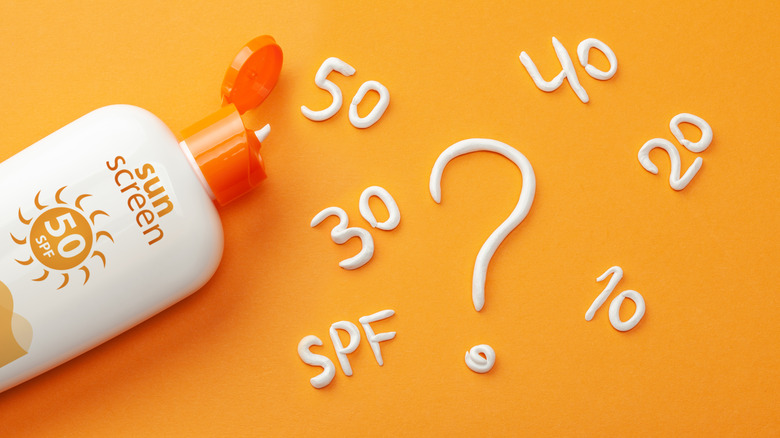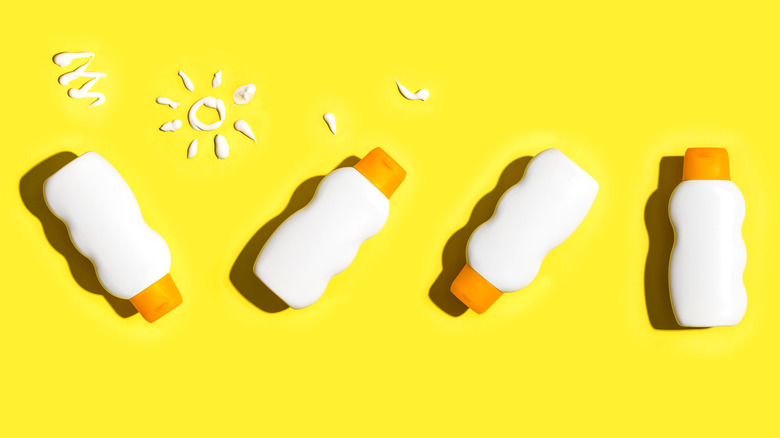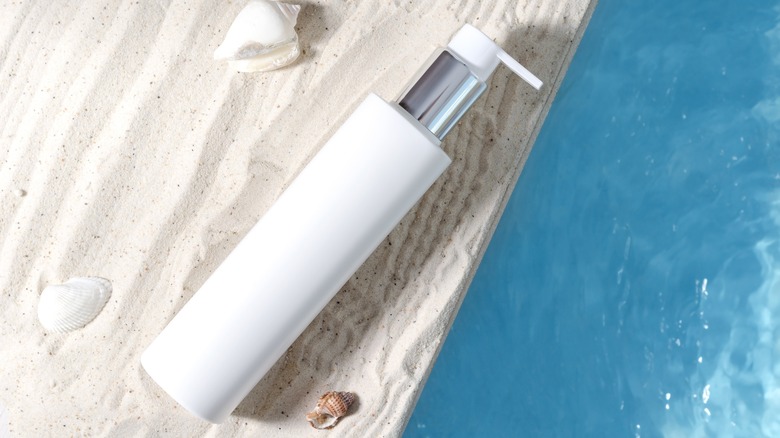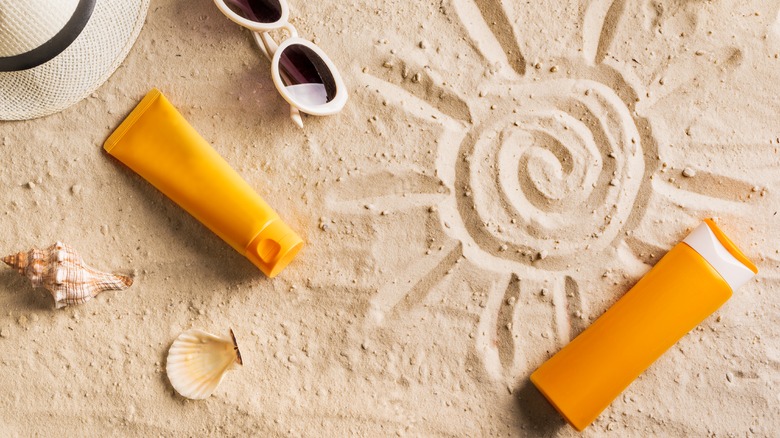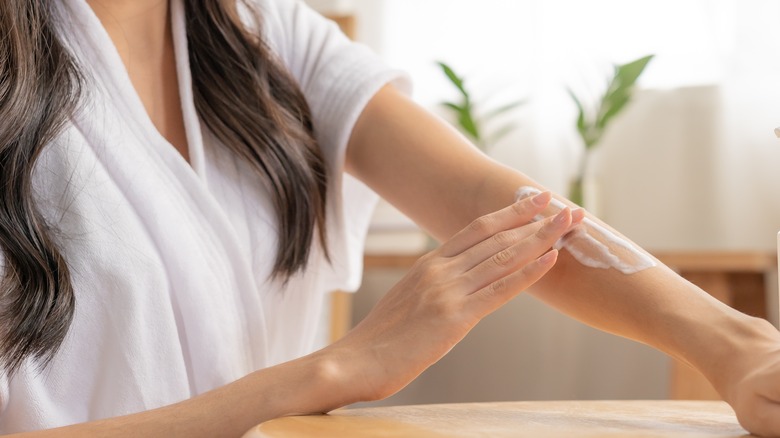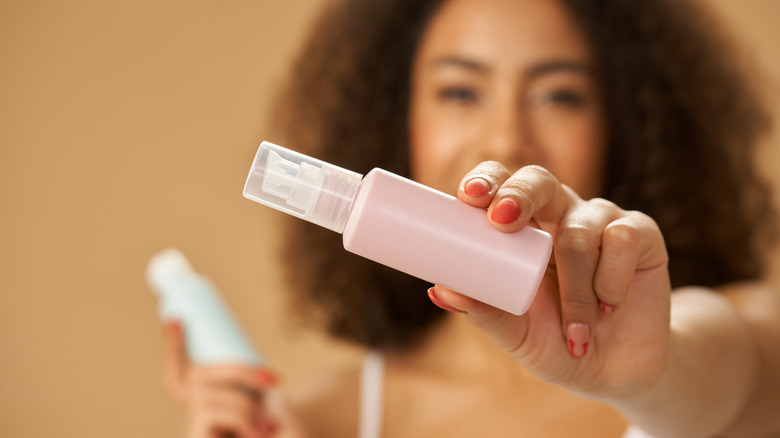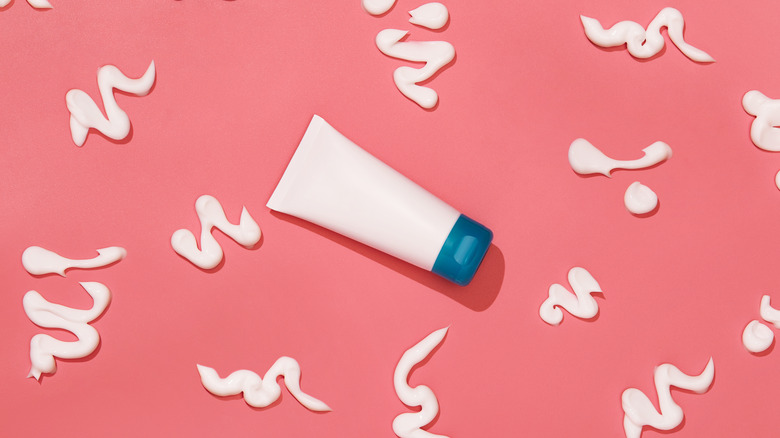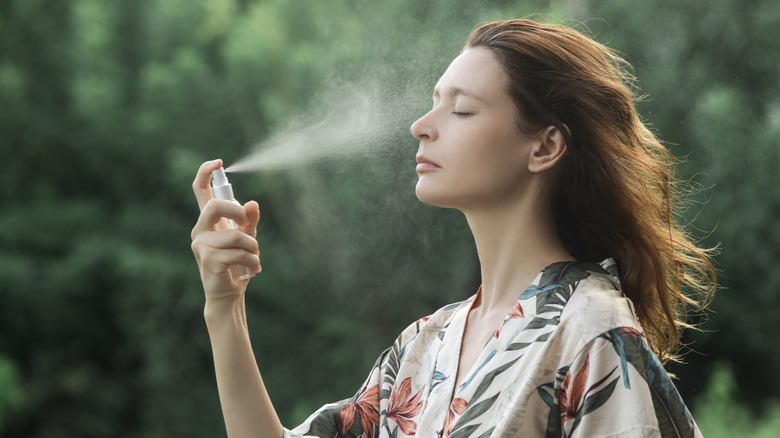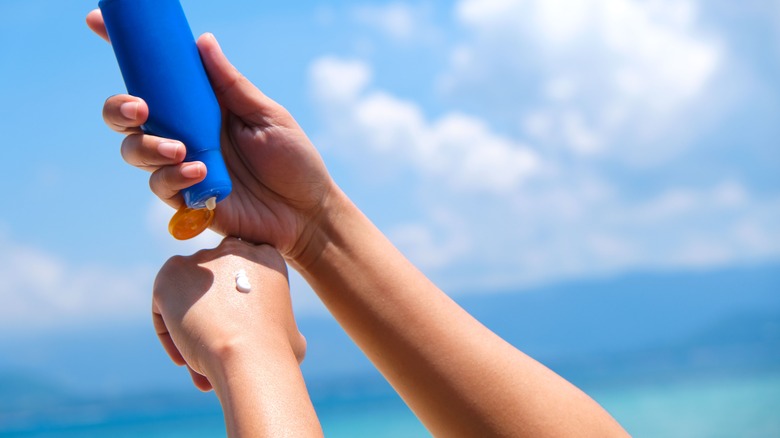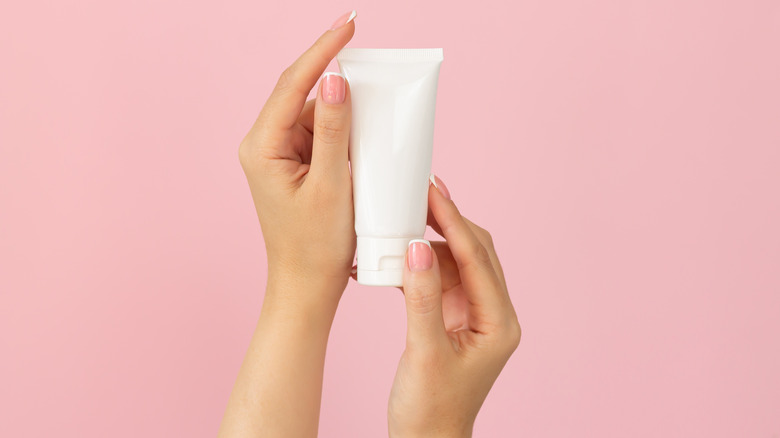How To Choose The Best Sunscreen For Your Skin
Sunscreen is an essential beauty product to include into your skincare collection. It helps to protect from the sun's rays — composed of UVA and UVB — since they are harmful to the skin and can lead to cancer, melanoma, premature aging, and more minor skin conditions such as moles, uneven skin tone, deep wrinkles, and sun spots (via the American Cancer Society).
According to the American Academy of Dermatology Association, "It is estimated that approximately 9,500 people in the U.S. are diagnosed with skin cancer every day." Whether it's spring, summer, fall, or winter, dermatologists recommend using it daily on your skin when you leave your home and are exposed to the sun's rays. But using it alone is not enough — dermatologists recommend wearing sunglasses, a hat, protective clothing, and staying out of the sun during the hot hours of the day. The American Cancer Society states that, "UV rays are strongest between 10 a.m. and 4 p.m."
With so many choices available, how do you choose the one that suits you best? Your skin color, lifestyle, and the protection level of the sunscreen are all factors to consider. Here's how to choose the best sunscreen for your skin.
Choose the right SPF
If you're a little confused by all the terms: UVA, UVB, SPF, and so on, we can feel you. When it comes to choosing a sunscreen, many possibilities are available, especially regarding the level of protection — more commonly known as SPF. It's important to understand how Sun Protection Factors work to ensure optimal skin protection for a day under the sun. The coefficient allows us to estimate the efficiency of the protection against UVA and/or UVB rays. Calculated in a laboratory, these indices translate the time required to get a sunburn. For example, according to the British Association of Dermatologists, an SPF of 15 will allow you to stay 150 minutes in the sun without getting a sunburn.
With that in mind, how do you choose the optimal SPF for your skin between 10, 15, 30, and 50?
"SPF 15 sunscreens filter out about 93% of UVB rays, while SPF 30 sunscreens filter out about 97%, SPF 50 sunscreens about 98%, and SPF 100 about 99%," explains the American Cancer Society. Indeed, no sunscreen can provide 100% protection from the sun's rays. However, dermatologists at the American Academy of Dermatology Association recommend using an SPF of more than 30, because an SPF of 15 will only protect against sunburn, but not against skin cancer or skin aging.
Choose the format suited for you
You need to find the sunscreen formula (and format) that fits you perfectly — this is according to your activities and lifestyle, as well as preference. Lotion, spray, stick, gel — you name it, there's a sunscreen adapted for a variety of requirements and desire.
Let's start with spray. Spraying sunscreen is useful and practical because it's quick to apply. However, there is a good chance you'll miss a spot and therefore reduce the effectiveness of the protection. A generous layer is necessary to spread the sunblock evenly.
Next up: The stick. It's ideal for small surfaces and quick touch-ups during the day. The ears, back of the neck, back of the knees — these areas tend to be difficult to access but they get sunburned very quickly. The stick is consequently perfect for adding another layer of protection every couple of hours, especially if you're constantly in the sun. And for everyday use, stick sunscreens are easy to slip into your purse.
Sunscreen lotion is the most commonly used, and it allows for uniformity when applied to the skin evenly. You can also find gels, which give a matte finish — while gels aren't very common in the United States they do protect the skin just as well (via Everyday Health.) Play around with a few of these to see what you like and what works best for your needs, according to your lifestyle and skin.
Look for water-resistant
When choosing sunscreen, check the label on the bottle for "water-resistant" since moisture, water and perspiration will have an impact on its effectiveness. According to the sunscreen brand We Are Feel Good Inc., "Water resistance is measured by determining the SPF (sun protection factor) of the product after it has been in the water for the period of time claimed on the product."
Please note that there is no such thing as a waterproof sunscreen, they are only more or less water resistant. Indeed, "so the FDA [Food and Drug Administration] no longer allows manufacturers to claim that a sunscreen is waterproof" (via the American Academy of Dermatology Association). According to the association, water-resistant sunscreens "stays effective for 40 minutes in the water. At that time, you'll need to reapply," while ultra water-resistant sunscreens can last twice as long: 80 minutes.
If you can't spot the words "water-resistant," "40 minutes," or "80 minutes" on the label, it means that the product will come off when it comes into contact with water or sweat. And if you're not sure, choose special sports sunscreens that are designed to resist skin moisture.
Pick one with a broad spectrum
Do you remember high school science class? Especially that lesson about the sun and its rays? Let's refresh your memory — because these powerful rays play an important role in the deterioration of the skin.
Ultraviolet (UV) rays are the most harmful to the skin. These rays are divided into two categories, UVB and UVA. They both play a big role in skin aging and can cause skin cancer (per University of Iowa Hospitals & Clinics). That's why it's important to look carefully at the label of your sunscreen bottle and choose "a sunscreen that is labeled broad-spectrum or indicates that it provides coverage against both UVA and UVB as we know both can contribute to skin aging and skin cancer," says Dr. Marisa Garshick, New York-based board-certified dermatologist (via Forbes).
Broad-spectrum sunblock also helps promote and maintain healthy skin, and it preserves collagen (per Color Science).
Choose a sunscreen according to your skin color
The color of your skin is determined by the amount of melanin it contains. This pigment is responsible for the color of your hair, eyes, and also skin. The more melanin you have in your body, the darker your skin will be. The sun's rays increase melanin production and allow you to get that tan you desire in summer. However, they are also responsible for sunburn — the less melanin you have in your body (so, the whiter your skin) the more sensitive it is to damaging UVA and UVB.
Project Sunscreen sheds light on this. Very fair, milky skin, often possessed by blonds, redheads, and people with freckles needs maximum protection. These skin types should opt for an SPF of 50 or more. Tanned skin is intermediate skin, it's not as sensitive or fragile as fair skin but still requires an SPF 50 during the hottest hours of the day. While matte skin, slightly darker, tans intensely and evenly, and needs a sunscreen with an SPF 30. This type of skin rarely burns and darkens easily in the sun. However, even the darkest skin still needs protection, according to dermatologists – and the cream (with a low SPF) will help reduce the effects of aging.
Know the difference between physical and chemical sunscreen
As you now know, sunscreen blocks UV rays from penetrating the different layers of your skin — epidermis and dermis. The are two types of sunscreens are on the market: physical and chemical. Physical sunscreen "works by creating a barrier on top of the skin that shields the sun's rays," describes board-certified dermatologist Dr. Ellen Marmur for Today. While chemical sunscreen does the opposite — it doesn't act like a mirror by repelling the rays but instead absorbs them before they hit the skin, so they only penetrate the epidermis and dermis to a minimum.
It's essential to know the difference between the two in order for you to choose the best sunscreen based on your preference. Above all, the board-certified dermatologist Nana Duffy explains for Healthline that, "The most effective sunscreen is the one you will use."
Choose a sunscreen according to your skin type
If you don't know your skin type yet, you should analyze it more closely. For example, if you have dry skin, some skin particles will be visible on the surface. Knowing your skin type allows you to choose the right skincare products — and this includes sunscreen.
If you have dry skin, a sunblock that moisturizes will be the most suitable — go for a cream that contains ingredients like hyaluronic acid and allantoin which will deeply moisturize your skin while providing protection from the sun.
Dr. Joshua Zeichner, director of cosmetic and clinical research at Mount Sinai Hospital, advises the magazine Better that "If you have acne or oily skin, make sure that your sunscreen is labeled as 'non-comedogenic,' which means that it has been shown not to block pores."
For people with sensitive skin, who tend to react quickly, Emily Smith, dermatologist at the University of Missouri, advises applying a physical or mineral sunscreen containing zinc oxide and titanium dioxide (via MU Health Care). If you have oily skin, however, you don't want your sunscreen to give you acne, so choose a non-comedogenic cream to avoid clogging your pores. Ingredients such as niacinamide or lactic acid will help prevent acne. The best one? A completely oil-free sunscreen.
Check the expiration date
When shopping at the supermarket, it would never occur to you to buy a pack of cookies that have already expired, so make sure you do the same when buying sunscreen. Like all beauty products, sunscreen has an expiration date. It's important to respect that date so you don't end up just smearing a moisturizer on your face and going out under the sun without realizing you're no longer protected from harmful rays.
After a certain time, the components of the cream no longer act as effectively. Sunblock can be kept for about six months, as indicated on the packaging. However, sunscreen can be kept for up to three years "as long as it's been stored in a cool, dry area," says dermatologist Alok Vij (via the Cleveland Clinic).
Opened or not, the cream must be stored in a dry environment and protected from light and heat to preserve all its qualities. "Storing the bottle in a hot or humid area can quickly break down many of the active ingredients that block UV rays," adds Dr. Vij. And if you thought about buying sunscreen because of a special sale, Dr. Vij also explains that this is not the best solution: "It could have been kept in a hot warehouse all summer long. At that point, the active ingredients may have already gone bad."
Consider your lifestyle
The small activities in your daily life have a big impact on your choice of sunscreen — work, activities, and general lifestyle are all factors. And for good reason: Your skin will have various needs depending on how often you're exposed to the sun's rays, and whether your skin sweats easily, etc. For example, if you are exposed to the sun most of the day, dermatologists advise you choose a sunscreen with a high SPF that covers both UVA and UVB rays and to reapply it every two hours.
If you play sports regularly, it's best to consider water and sweat-resistant sunscreen (via Sol RX). It will permit your skin to be protected in all circumstances without disturbing your daily sports session.
Moreover, if you have tattoos and love showing them — particularly in summer — you'll need to safeguard that ink! Tattoos, especially recent ones, must be protected from the sun so that they don't tarnish and fade. "A new tattoo is an open wound, and exposing it to UV rays can lead to swelling, blisters, redness, itchiness, and peeling of the skin," explains Brush on Block. So it's advisable to invest in a good sunscreen and not skimp on the application.
Choose the best ingredients
Chances are your bathroom shelves are full of products — but are they all healthy for your skin? Likely no. More people want to incorporate "clean" products into their beauty routines. And so, like with all skincare products, you should read sunscreen labels carefully. Sunscreens are made up of a whole list of ingredients — so it stands to reason that not all of these ingredients are healthy, and many are downright confusing. That's why you should know how to spot the good stuff.
For an ingredient to be added to sunscreen, it must first be validated by the Food and Drug Administration (per ChemicalSafetyFacts), among which we can count zinc oxide and titanium dioxide that aren't harmful to the skin. "EWG [Environmental Working Group] says these have undergone testing and are considered to be safe," explains The List. And niacinamide and lactic acid won't give you acne outbreaks, redness, or itching — and they will protect and moisturize your skin as well as clean your pores (via Self).
Moreover, we can count among the safe ingredients Sodium Hyaluronate, which brings water to the skin and hydrates it deeply and Tocopheryl Acetate. This molecule acts on the skin like vitamin A, an antioxidant that helps reduce the effects of aging (via Inci Decoder).
Stay away from dangerous ingredients
Because not all sunscreens are created equal, identifying quality ingredients is just half the battle — you must also be aware of ingredients that may be harmful to your skin and should be avoided. Some ingredients can cause skin reactions, allergies, and in the worst cases "the potential to cause cancer, disrupt the hormone system and cause harm during reproduction and development" (per the Environmental Working Group).
According to The List the, "EWG is especially worried about the effect of oxybenzone, which studies show may mimic hormones. Oxybenzone is one of six ingredients commonly used in chemical sunscreens today." Not only is this petrochemical bad for the body because it can be absorbed into the bloodstream, but it is also bad for marine biodiversity. According to the EWG, oxybenzone "causes allergic skin reactions ... behaves like an endocrine disruptor in many studies ... and is potentially of greater harm to children."
And octinoxate "has hormone effects on the metabolic system and ... can cause allergic reactions after exposure to ultraviolet light." Octisalate, octocrylene, and avobenzone are also UV filters to avoid because they are "all systemically absorbed into the body after one use" (via the EWG).
